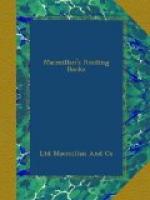The gunpowder had loosened a large mass in one of the inferior strata, and our first employment, on resuming our labours, was to raise it from its bed. I assisted the other workmen in placing it on edge, and was much struck by the appearance of the platform on which it had rested. The entire surface was ridged and furrowed like a bank of sand that had been left by the tide an hour before. I could trace every bend and curvature, every cross-hollow and counter-ridge of the corresponding phenomena; for the resemblance was no half-resemblance—it was the thing itself; and I had observed it a hundred and a hundred times when sailing my little schooner in the shallows left by the ebb. But what had become of the waves that had thus fretted the solid rock, or of what element had they been composed? I felt as completely at fault as Robinson Crusoe did on his discovering the print of the man’s foot on the sand. The evening furnished me with still further cause of wonder. We raised another block in a different part of the quarry, and found that the area of a circular depression in the stratum below was broken and flawed in every direction, as if it had been the bottom of a pool, recently dried up, which had shrunk and split in the hardening. Several large stones came rolling down from the diluvium in the course of the afternoon. They were of different qualities from the sandstone below, and from one another; and, what was more wonderful still, they were all rounded and water-worn, as if they had been tossed about in the sea, or the bed of a river, for hundreds of years. There could not, surely, be a more conclusive proof that the bank which had enclosed them so long could not have been created on the rock on which it rested. No workman ever manufactures a half-worn article, and the stones were all half-worn! And if not the bank, why then the sandstone underneath? I was lost in conjecture, and found I had food enough for thought that evening, without once thinking of the unhappiness of a life of labour.




